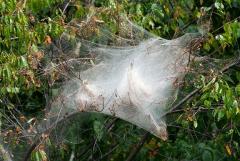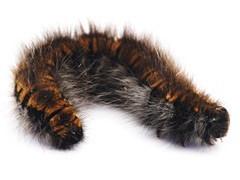A frequent question to the Gardening Advice Line written by the Vancouver Island Master Gardeners Association volunteers.
Question: What to do about tent caterpillars?
In Canada, the three most common types of tent caterpillars are the Eastern tent, the Western tent, and the Forest tent caterpillar.
Caterpillars feed on deciduous trees in most parts of southern Canada:
- The Eastern tent caterpillar feeds mainly on cherry, apple, and crab apple trees.
- The Western tent caterpillar chooses willow, poplar, apple, plum, cherry, and oak.
- Forest tent caterpillars seem to prefer trembling aspen and poplars in Canada, but also feed on many other trees like American beech, apple, basswood, cherry, white ash, birch, mountain ash, sugar maple, red oak, white elm, and willow.
Tent caterpillars lay eggs or egg masses, caterpillars from one egg mass stay together to spin a silken tent in the branches of a tree and may unite to form a colony.
Eastern and forest tent caterpillar moths lay their eggs in late June or early July. The Western tent caterpillar moth appears later and lays eggs in August. They eggs are laid in large groups and encased in a frothy web that forms a dark brown or gray band and wraps itself around the branches of susceptible trees. When the leaves open in spring, the eggs hatch into young caterpillar larvae and enclose the branches. The size of the tent increases as the larvae grow. In June or July, the caterpillars cover themselves in cocoons and build silk trails along the tree’s branches. Tent caterpillar outbreaks are periodic, but do not happen on an exact schedule because they depend on several environmental and biological factors. Although they seldom kill the infested tree, these caterpillars can cause severe damage, often nearly defoliating the entire tree.
If damage is minor and the tree is healthy, the tree can bud again later in the summer. However, repeated defoliation can weaken trees and make them more susceptible to other types of stress.
What to do about tent caterpillars?
When deciding what to do, keep in mind that tent caterpillars have only one generation a year, and each female lays only a single egg mass. Since tent caterpillars are native to North America, insect parasites and natural predators like birds and rodents control a certain amount of the population. However, sometimes a more drastic means of control may be needed where infestations are severe.
1. Destroying cocoons and egg masses
In the summer, look for tough, yellow-to-white cocoons on tree trunks, fences, debris, and sheltered areas. In the fall, look for shiny, dark brown or gray saddle-like cases which straddle or encase twigs of trees that are known to be susceptible to tent caterpillar infestations. Destroy egg cases and cocoons by scraping them off carefully (to avoid damage to the bark) and dispose of them in a sealed bag.
In the spring, if webs are present, colonies of young larvae can be removed by clipping and destroying the tents and caterpillars. This is best done when the caterpillars are at rest in the tent, either in early morning, late evening, or on cool rainy days. A pole pruner can be used to remove the nests in taller trees.
2. Biological control
2a. The bacterium B.t. (Bacillus thuringiensis) is a selective biological insecticide. After eating vegetation treated with B.t., caterpillar larvae will stop feeding and die within five days. Thorough coverage of foliage is needed, and spraying should not be done until the first signs of leaf damage appear. Younger larvae are more susceptible to this product.
Insects other than the larvae of moths and butterflies are not affected by B.t. made to be used against caterpillars. Products that contain this bacterium are also non-toxic to mammals, birds, and fish.
2b. If you have an infestation of caterpillars, you can use a dormant oil spray on susceptible trees in late winter to smother the eggs before they hatch in early spring. Dormant oils are thick oils used mainly on fruit trees to control overwintering eggs, mites, scales, and other insects. Dormant oils can cause damage to plants if not used according to directions, so follow all label instructions.
2c. There are other pesticide products registered for the control of tent caterpillars as well. If the tent is within reach, break it open with a stick and direct the insecticide into it. Spraying is most effective in the evening, as the caterpillars return to the nesting area at night.
Reference:
Tent Caterpillar Control: How to Identify, Prevent and Get Rid of Tent Caterpillars



